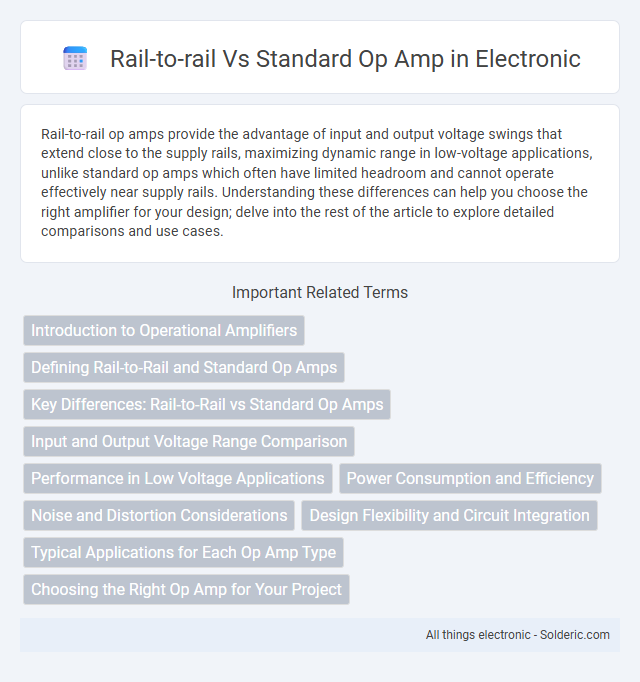Rail-to-rail op amps provide the advantage of input and output voltage swings that extend close to the supply rails, maximizing dynamic range in low-voltage applications, unlike standard op amps which often have limited headroom and cannot operate effectively near supply rails. Understanding these differences can help you choose the right amplifier for your design; delve into the rest of the article to explore detailed comparisons and use cases.
Comparison Table
| Feature | Rail-to-Rail Op Amp | Standard Op Amp |
|---|---|---|
| Input Common Mode Range | Includes both supply rails | Limited, not reaching rails |
| Output Voltage Swing | Close to supply rails (rail-to-rail) | Typically several volts away from rails |
| Supply Voltage | Operates at low voltage (e.g., 1.8V to 5V) | Requires higher voltage for full range |
| Power Consumption | Normally higher due to design complexity | Can be lower in simpler designs |
| Applications | Battery-powered devices, low-voltage systems | General-purpose amplification |
| Linearity | Improved at extremes near rails | Potential distortion near rails |
Introduction to Operational Amplifiers
Operational amplifiers (op amps) are essential components in analog electronics, used to amplify voltage signals with high gain. Rail-to-rail op amps allow the output voltage to swing close to the supply rails, maximizing dynamic range within low-voltage applications. Standard op amps typically have limited output range away from supply rails, making rail-to-rail designs more suitable for modern battery-powered and low-voltage systems.
Defining Rail-to-Rail and Standard Op Amps
Rail-to-rail operational amplifiers are designed to operate input and output voltages that can swing close to the supply rails, maximizing dynamic range in low-voltage applications. Standard op amps typically have input and output voltage ranges limited to a level several volts below the rails, which can reduce signal amplitude and linearity. Your choice between these types depends on the required voltage range and application constraints.
Key Differences: Rail-to-Rail vs Standard Op Amps
Rail-to-rail op amps offer input and output voltage ranges that extend close to the supply rails, enabling maximum signal swing in low-voltage applications, unlike standard op amps which have limited input/output ranges and require higher supply voltages. Rail-to-rail designs improve performance in battery-powered devices by maximizing dynamic range and minimizing distortion, whereas standard op amps may saturate or clip signals near supply limits. Your choice depends on application requirements for signal headroom, power consumption, and operating voltage range.
Input and Output Voltage Range Comparison
Rail-to-rail operational amplifiers provide an extended input and output voltage range, allowing signals to approach both the positive and negative supply rails, typically within just a few millivolts. Standard op amps often have limited input common-mode voltage ranges and output swings that cannot reach the supply rails, reducing usable signal range and potentially affecting precision in low-voltage applications. Choosing a rail-to-rail op amp ensures Your circuit maximizes dynamic range and accuracy, especially in battery-powered or single-supply systems.
Performance in Low Voltage Applications
Rail-to-rail op amps excel in low voltage applications by maximizing input and output voltage swings close to the supply rails, enabling better utilization of limited voltage headroom. Standard op amps often struggle with reduced performance in low voltage scenarios due to limited input common-mode range and output swing, which can lead to signal distortion or clipping. Choosing a rail-to-rail op amp ensures your low voltage circuit maintains accuracy and dynamic range without compromising on power efficiency.
Power Consumption and Efficiency
Rail-to-rail op amps optimize power consumption by allowing output voltage to swing close to supply rails, reducing the need for higher supply voltages and increasing efficiency in low-voltage applications. Standard op amps typically require higher supply voltages and have limited output swing, which can increase power consumption and reduce overall efficiency. Your choice between the two should consider the trade-off between power savings and the specific voltage range needed for your application.
Noise and Distortion Considerations
Rail-to-rail op amps often exhibit higher noise levels compared to standard op amps due to their input stage design, which can introduce additional distortion and impair signal integrity in low-voltage applications. Standard op amps typically provide lower noise floors and reduced harmonic distortion, making them preferable in precision analog circuits where signal fidelity is critical. Selecting between rail-to-rail and standard op amps requires balancing noise performance against the need for full-scale input/output voltage swing.
Design Flexibility and Circuit Integration
Rail-to-rail op amps offer enhanced design flexibility by allowing input and output signals to swing close to the supply rails, enabling full utilization of low voltage power sources in compact circuit designs. Standard op amps, limited by input and output voltage ranges, may require additional components or higher supply voltages, hindering seamless circuit integration. Choosing rail-to-rail amplifiers simplifies your design process and facilitates tighter integration in modern, low-voltage electronic systems.
Typical Applications for Each Op Amp Type
Rail-to-rail op amps excel in battery-powered devices and portable instrumentation where maximizing the input and output voltage range is crucial, enabling full utilization of low-voltage supplies. Standard op amps are preferred in high-precision analog signal processing, audio equipment, and industrial control systems where wider voltage rails and lower noise are more critical than output range. Selecting the appropriate amplifier ensures your design meets performance requirements, balancing voltage range and signal fidelity.
Choosing the Right Op Amp for Your Project
Rail-to-rail op amps provide input and output voltage ranges that extend close to the supply rails, making them ideal for low-voltage and single-supply applications requiring maximum signal swing. Standard op amps typically have limited input/output voltage ranges, suitable for higher voltage or dual-supply systems where headroom is less critical. Selecting the right op amp depends on the supply voltage, input/output voltage requirements, and power consumption constraints specific to your project's needs.
Rail-to-rail vs Standard op amp Infographic

 solderic.com
solderic.com